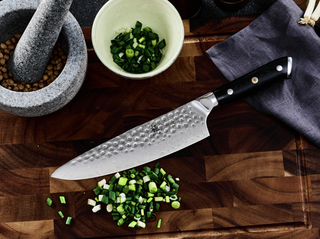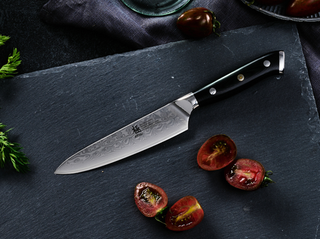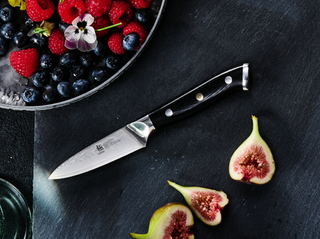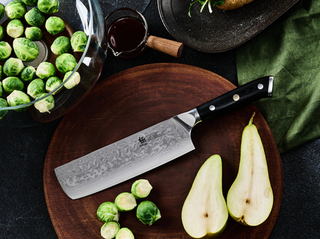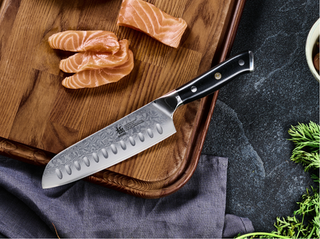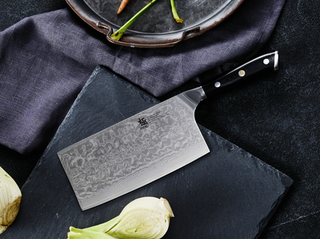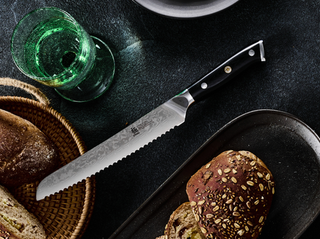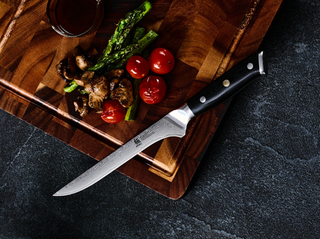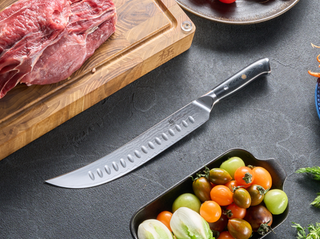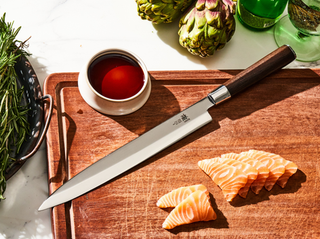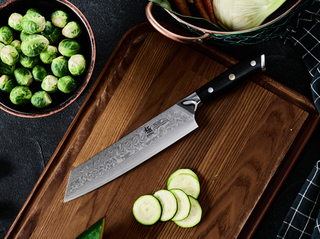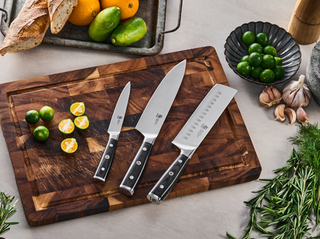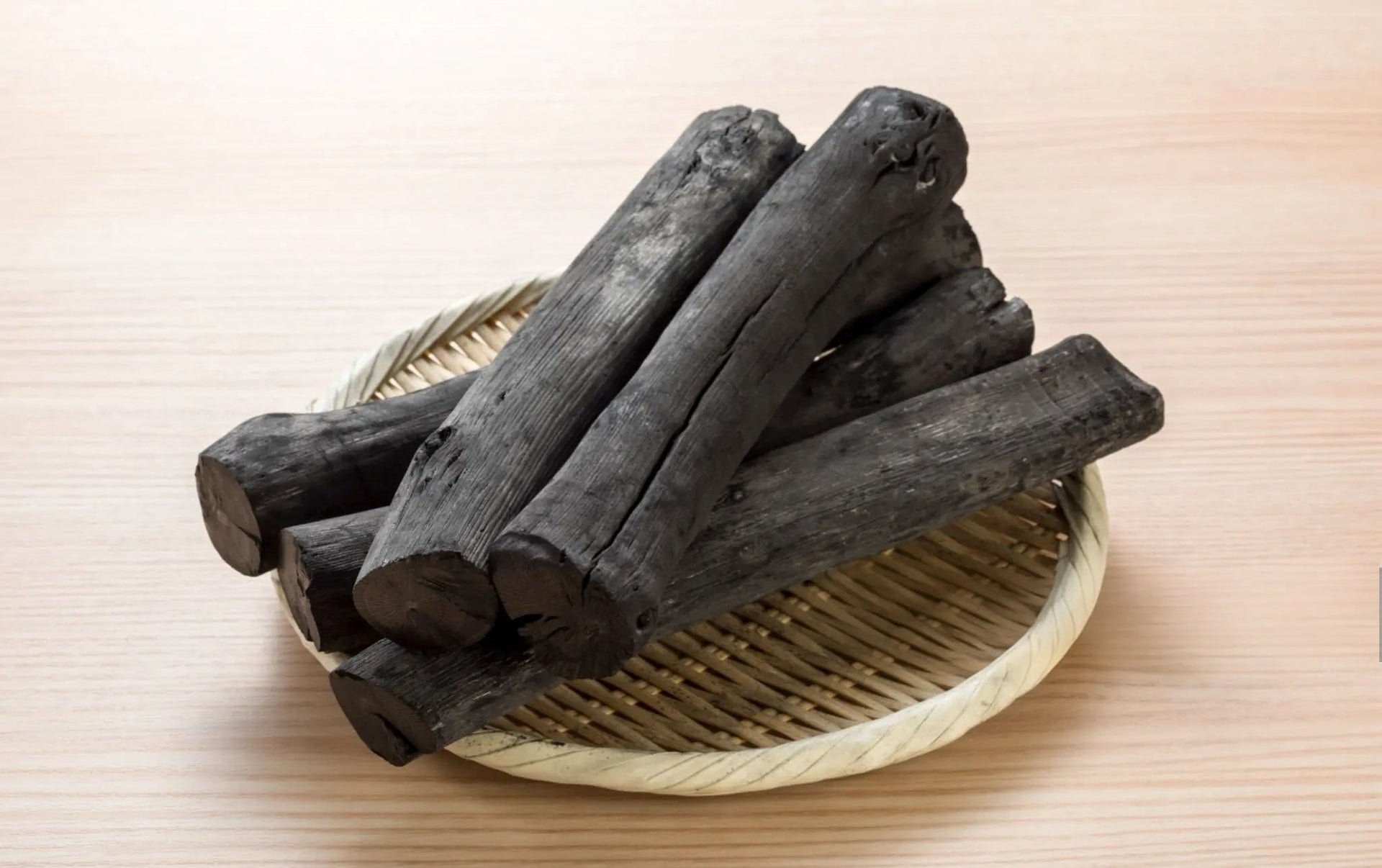Binchotan (備長炭) is premium Japanese white charcoal that master chefs and bladesmiths have treasured for centuries. Dating back to the 1600s, it was first created by a craftsman named Bicchuya Chozaemon in Wakayama Prefecture. Its distinctive white coating comes from the unique finishing process that sets it apart from ordinary charcoal.
How Binchotan Charcoal Changes Japanese Cooking

Binchotan charcoal reaches extreme temperatures of up to 1,800°F while burning virtually smokeless. This clean-burning fuel creates the perfect cooking environment for traditional Japanese cuisine.
The intense, consistent heat from binchotan seals in natural flavors without adding unwanted smoke taste. This is why top Japanese restaurants worldwide insist on using it for yakitori, robatayaki, and other grilled specialties. The pure taste it creates simply cannot be replicated with regular charcoal.
How Binchotan Is Different From Regular Charcoal
Regular charcoal is black, soft, and burns quickly. Binchotan is much harder and denser. When you tap it, it rings like metal! It burns for hours instead of minutes.

Binchotan is nearly pure carbon - about 95% compared to regular charcoal's 75%.
This purity means cleaner cooking with fewer chemicals in your food. Your grilled foods taste better because there are no unwanted flavors from the fuel.
How Master Artisans Create Binchotan
The creation of binchotan represents the pinnacle of Japanese charcoal-making craftsmanship.
The process begins with carefully selected Ubame oak (ウバメ樫), a specific Japanese white oak species with exceptionally dense wood structure.
Traditional kilns built from clay and stone house the transformation process that takes over a week to complete. The initial slow-burning phase at controlled temperatures removes moisture and volatile compounds while preserving the wood's carbon structure.
What truly distinguishes binchotan from ordinary charcoal comes next.
Instead of extinguishing the fire, master craftsmen perform a technique called "Seiren" (精錬) or refinement. They precisely increase oxygen flow to boost temperatures above 1,000°C (1,832°F). This extreme heat creates binchotan's characteristic dense structure and 95% carbon purity that knife makers and chefs prize.

The final phase involves removing the glowing-hot charcoal and covering it with a mixture of sand and ash. This rapid cooling process creates the distinctive white coating that gives binchotan its "white charcoal" name. The entire traditional process requires approximately 10 days and yields only about 600kg per batch – explaining both its rarity and value.
Other Uses For Binchotan Charcoal
Binchotan isn't just for cooking. It's also amazing at purifying water by removing chemicals and adding minerals. Many people in Japan put binchotan pieces in their water pitchers.
It works as a natural air freshener too. It can absorb odors and moisture in rooms, refrigerators, and shoes. Some people even use binchotan in their bath water because they believe it has health benefits.
How to Use Binchotan at Home
Getting started with binchotan takes a little patience. It's harder to light than regular charcoal but burns much longer. Most experts recommend using a chimney starter or gas burner to get it going.
Once lit, binchotan keeps a steady temperature for hours. This makes it perfect for long cooking sessions. You'll use less charcoal overall, which helps offset the higher initial cost.
The Environmental Side of Binchotan Charcoal
Traditional binchotan makers practice sustainable harvesting. They carefully select trees without damaging forests. The best producers only harvest what nature can replace.
Unfortunately, as binchotan becomes more popular worldwide, some companies over-harvest the trees. If you buy binchotan, look for suppliers who follow traditional sustainable practices.
The Secret Relationship Between Japanese Knives and Binchotan Charcoal
Japanese knife crafting and binchotan charcoal share an ancient and vital connection that few people know about.
Traditional Japanese bladesmiths specifically choose binchotan for their forges when crafting premium knives like Yanagiba, Santoku, and Gyuto. The exceptionally pure, consistent heat transforms raw steel into world-renowned cutting instruments.
Unlike other fuel sources, binchotan creates a smokeless, impurity-free environment essential for forging perfect knife steel.

This contamination-free heat allows the metal's crystal structure to form properly, creating blades with superior hardness, edge retention, and cutting performance. The stable temperature control helps craftsmen achieve precise hardening and tempering.
Many master bladesmiths also use binchotan's fine white ash as a traditional final polishing medium. This natural abrasive creates the mirror-like finish characteristic of high-end Japanese knives without risking micro-scratches on the polished surface. This deep connection between cooking fuel and cooking tools represents the holistic philosophy behind Japanese culinary traditions.
How to Identify and Purchase Authentic Japanese Binchotan
Authentic Japanese binchotan produces a distinctive metallic ring when pieces are tapped together – a key test for identifying premium quality.
Look for extremely hard, dense sticks with a characteristic white or silvery coating. While premium binchotan costs significantly more than regular charcoal, its extraordinary burn time (up to 5 hours) makes it economically worthwhile.
The most coveted variety, Kishu Binchotan from Wakayama Prefecture, commands the highest prices due to its exceptional purity and performance. Other respected regional varieties include Tosa Binchotan and Miyazaki (Hyuga) Binchotan, each with slightly different characteristics preferred by different knife makers and chefs.
Elevate Your Japanese Cooking and Knife Collection
Discovering binchotan charcoal opens up a deeper appreciation of Japanese culinary traditions. Whether you're a professional chef, a knife collector, or a home cooking enthusiast, understanding this crucial element helps explain what makes Japanese kitchen tools and cooking techniques so exceptional.
Experience firsthand why Japanese masters have relied on this special charcoal for centuries. Add authentic binchotan to your cooking arsenal and witness the difference in both flavor and connection to traditional craftsmanship. The same charcoal that forges the world's finest knives can transform your cooking results.
If you are interested in learning more about Japanese knives knowledges and how to use and care for them, check them out on Kyoku Knives Chef Blogs!
Binchotan Charcoal FAQ
Q1: What is Binchotan charcoal and why is it so special?
A1: Binchotan is premium Japanese white charcoal known for burning super clean and at very high temperatures—up to about 1800°F—with almost no smoke. It’s perfect for traditional Japanese cooking and crafting top-quality knives.
Q2: How is Binchotan different from regular charcoal?
A2: It’s much harder, denser, and burns longer than regular charcoal. Binchotan has about 95% carbon purity, compared to 75% for regular charcoal, which means cleaner heat and better tasting food without unwanted smoky flavors.
Q3: What makes the Binchotan making process unique?
A3: It uses special Ubame oak and a traditional 10-day firing and refining process called “Seiren,” where high temperatures and rapid cooling create its distinctive white coating and dense carbon structure.
Q4: Besides grilling, what other uses does Binchotan have?
A4: It’s great for purifying water, absorbing odors and moisture, and even has some believed health benefits when used in baths.
Q5: Why do Japanese chefs and knife makers prefer Binchotan?
A5: Because its pure, smokeless heat is ideal for forging and hardening knives, helping create blades with superior sharpness and durability. The fine white ash even serves as a natural polishing agent.
Q6: How can I tell if the Binchotan I’m buying is authentic?
A6: Authentic Binchotan will have a metallic ringing sound when pieces are tapped together. It’s very hard, dense, and coated with a characteristic white or silvery layer.
